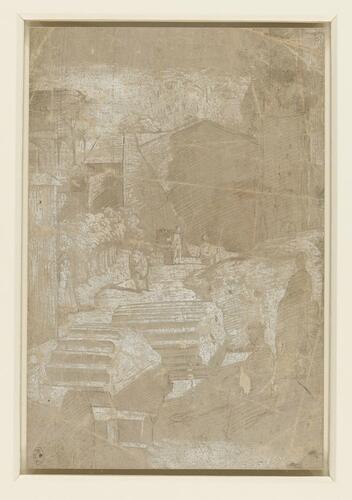A landscape with figures and ruins c.1512
Metalpoint and lead white on buff prepared paper; much creased and abraded | 21.0 x 14.1 cm (sheet of paper) | RCIN 990117
-
This striking drawing depicts a lane in sunlight, with the drums of an antique fluted column scattered in the foreground and large plain buildings beyond. The thick white heightening that captures the bright light has obscured some of the metalpoint drawing, but at least nine figures can be seen: three silhouetted to the right; a bearded man leaning on a stick to the left; a corpulent man in the middle of the lane; just to his right (and mostly hidden by a rise in the ground) a figure seen in bust length; another man standing apparently by a barrel; and to his right, a woman walking to the left followed by a child. It has been claimed that the Coliseum is visible in the left background, but what might appear to be two orders of arcading are in fact the branches of a tree, before a façade whose cornice brackets and attic windows can be seen close to the edge of the sheet.
The drawing was adapted for the right background of an engraving by Marcantonio Raimondi (Bartsch 417), traditionally known as Il Morbetto, which bears the inscription INV[ENTOR] RAP[HAEL] UR[BINAS]. The print depicts the plague that struck Phrygia whilst Aeneas and his companions were in Crete, and the apparition of the Penates to Aeneas during the night, as described in Virgil’s Aeneid (III, 140 and 148). In the Uffizi (inv. 525-E) is a study for the whole composition, on the same scale as the engraving and, as here, in reverse. There is no good reason to question the ascription of the whole design to Raphael, and the Uffizi drawing, although wrecked by damp and tears, seems certainly to be his model for the engraver.
The present drawing is consistent in style and technique with Raphael's metalpoint drawings around 1512, and a unique example of a pure landscape study by the master of figural composition. It was probably not made expressly for the engraving, but created instead as a coherent and self-sufficient study; it lacks the sinister mood of the print, or indeed any suggestion in its composition that Raphael had in mind its subsequent integration into a larger context. The changes from this drawing to the Uffizi model – such as the replacement of the corpulent figure by a dead horse – were Raphael's adaptations to the requirements of a narrative. The disturbing dichotomy of the print's design perhaps reflects this independent origin of one half of the composition, but Landau and Parshall (The Renaissance Print, 1994, p.124) suggested that this dichotomy was deliberate, dividing the print equally into a day scene and a night scene, and that this demonstration of the engraver's skill was one of the subtexts of the print.
Ravelli (Polidoro da Caravaggio 1978, p.96, no. 6) attributed the drawing to Polidoro, as a ‘personal critique’ of the left half of Raphael's composition; Gere (Master Drawings, 1985-86, p.67) rejected this, while acknowledging that the sheet is without parallel in Raphael's oeuvre, and suggested that some intervention of Polidoro in the composition was worth considering – but Polidoro can have been no older than his mid-teens when the engraving was designed.Provenance
Presumably in the Royal Collection by c.1810, but not traced in George III's 'Inventory A'.
-
Creator(s)
-
Medium and techniques
Metalpoint and lead white on buff prepared paper; much creased and abraded
Measurements
21.0 x 14.1 cm (sheet of paper)
Object type(s)
Subject(s)








